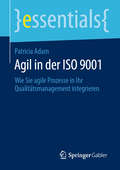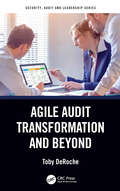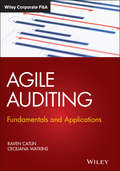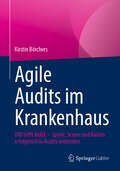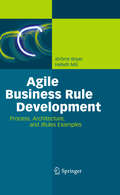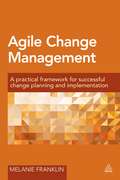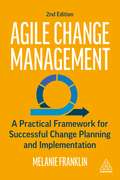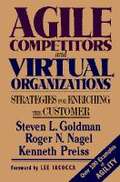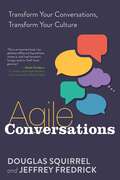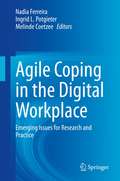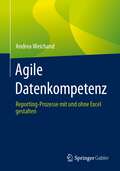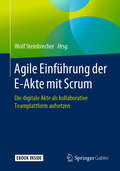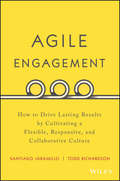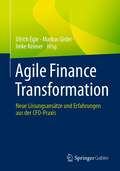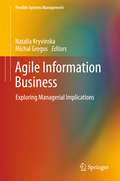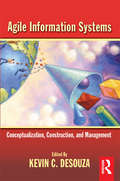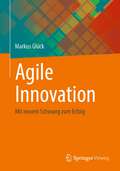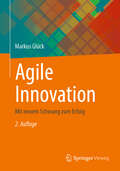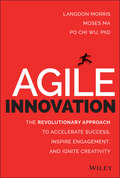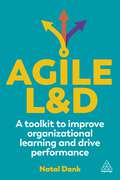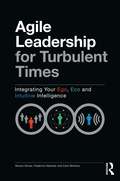- Table View
- List View
Agil in der ISO 9001: Wie Sie agile Prozesse in Ihr Qualitätsmanagement integrieren (essentials)
by Patricia AdamSie fragen sich, was an diesem „Agilitäts-Hype“ eigentlich dran ist und wann agiles Arbeiten wirklich Vorteile bringt? Sie überlegen, wie Sie Prozesse agiler gestalten können? Sie liebäugeln mit agilen Methoden, aber wissen nicht, wie Sie das Ihrem (ISO 9001-)Auditor erklären sollen? Patricia Adam hat dazu geforscht und Interviews mit Qualitäts- und Innovationsmanagern aus unterschiedlichsten Unternehmen und Branchen geführt. Ergänzt um Erkenntnisse aus ihrer aktuellen Auditpraxis und eine fundierte wissenschaftliche Analyse auf Basis von ISO 9001:2015 hat die Autorin daraus klare Leitlinien für die agile Organisationsentwicklung aufgestellt. Wenn Sie über Agilität fundiert mitreden wollen und Beispiele für die Nutzung von agilen Praktiken in einem Qualitätsmanagementsystem suchen, ist dieses essential für Sie genau richtig.
Agile 2: The Next Iteration of Agile
by Adrian Lander Kurt Cagle Cliff Berg Lisa Cooney Philippa Fewell Raj Nagappan Murray RobinsonAgile is broken. Most Agile transformations struggle. According to an Allied Market Research study, "3% of respondents stated the failure of agile implementation in their organizations." The problems with Agile start at the top of most organizations with executive leadership not getting what agile is or even knowing the difference between success and failure in agile. Agile transformation is a journey, and most of that journey consists of people learning and trying new approaches in their own work. An agile organization can make use of coaches and training to improve their chances of success. But even then, failure remains because many Agile ideas are oversimplifications or interpreted in an extreme way, and many elements essential for success are missing. Coupled with other ideas that have been dogmatically forced on teams, such as "agile team rooms", and "an overall inertia and resistance to change in the Agile community," the Agile movement is ripe for change since its birth twenty years ago. "Agile 2" represents the work of fifteen experienced Agile experts, distilled into Agile 2: The Next Iteration of Agile by seven members of the team. Agile 2 values these pairs of attributes when properly balanced: thoughtfulness and prescription; outcomes and outputs, individuals and teams; business and technical understanding; individual empowerment and good leadership; adaptability and planning. With a new set of Agile principles to take Agile forward over the next 20 years, Agile 2 is applicable beyond software and hardware to all parts of an agile organization including "Agile HR", "Agile Finance", and so on. Like the original "Agile", "Agile 2", is just a set of ideas - powerful ideas. To undertake any endeavor, a single set of ideas is not enough. But a single set of ideas can be a powerful guide.
Agile Audit Transformation and Beyond (Security, Audit and Leadership Series)
by Toby DeRocheAuditing at the speed of risk requires internal auditors to rethink the way we work. Agile auditing provides a path forward that blends the best elements from agile project management and internal audit best practices. Leaders in internal audit are ready to incorporate an agile audit mindset in their departments, but most of the available resources provide theoretical ideas. Even when outside consultants lead an agile transition, the consultants primarily focus on adding agile ceremonies without addressing the fundamental mindset change required for an agile audit transformation. This book provides a practical guide for audit leaders to follow as a playbook for implementing agile across their department, impacting every facet of the audit lifecycle, and addressing the mental shift required for making a lasting change. Every chapter includes discussion questions to facilitate discourse or just to help you analyze your own department. Next, we look at a typical internal audit department as they attempt the transition from a traditional audit methodology to agile auditing so we can learn from their missteps and successes. The guidance in Agile Audit Transformation and Beyond includes the basics of agile auditing, practical directions for shifting each phase of the audit life cycle, common hurdles faced during the transition, and forward-looking thought leadership on expanding beyond internal audit into agile assurance.
Agile Auditing: Fundamentals and Applications (Wiley Corporate F&A)
by Raven Catlin Ceciliana WatkinsMaster new, disruptive technologies in the field of auditing Agile Auditing: Fundamentals and Applications introduces readers to the applications and techniques unlocked by tested and proven agile project management principles. This book educates readers on an approach to auditing that emphasizes risk-based auditing, collaboration, and speedy delivery of meaningful assurance assessments while ensuring quality results and a focus on the areas that pose the greatest material risks to the business under audit. The discipline of auditing has been forever changed via the introduction of new technologies, including: Machine learning Virtual Conferencing Process automation Data analytics Hugely popular in software development, the agile approach is just making its way into the field of audit. This book provides concrete examples and practical solutions for auditors who seek to implement agile techniques and methods. Agile Auditing is perfect for educators, practitioners, and students in the auditing field who are looking for ways to introduce greater levels of efficiency and effectiveness to their discipline.
Agile Audits im Krankenhaus: DIN trifft AGILE - Sprint, Scrum und Kaizen erfolgreich in Audits einbinden
by Kirstin BörchersAudits im Krankenhaus werden oft noch sehr dokumentenlastig und auf ISO-Konformitätsprüfung ausgerichtet durchgeführt. Dabei geht es in Zeiten von E-Health, Digitalisierung und künstlicher Intelligenz (KI) im Krankenhaus längst um mehr und es ist vor allem eine flexiblere Herangehensweise gefordert. Die aktuellen Transformationsprozesse benötigen schnellere und dynamischere Anpassungen in der Organisation und bei den Abläufen. Mit Hilfe von agilen Audit-Instrumenten wie Scrum, Kaizen und Kanban können diese Herausforderungen gemeistert werden.Dieses Buch stellt nach einer Einführung in die Grundlagen von Audits die wichtigsten agilen Werte, Praktiken und Methoden vor, erläutert ihren möglichen Einsatz im Rahmen des allgemeinen Auditprozesses wie auch in den sogenannten „Audits im Sprint“. Agilität im Qualitätsmanagement und in der Durchführung interner Audits steht nicht im Widerspruch zum Leitfaden ISO 19011 „Auditierung von Managementsystemen“, in dem es um dieWirksamkeit und Eignung des QM-Systems sowie dessen Chancen zur Weiterentwicklung geht – sie ist vielmehr eine konsequente Weiterentwicklung. Best-Practice-Beispiele veranschaulichen, wie eine konkrete Umsetzung im Krankenhausumfeld aussehen kann.
Agile Business Rule Development: Process, Architecture, and JRules Examples
by Hafedh Mili Jérôme BoyerBusiness rules are everywhere. Every enterprise process, task, activity, or function is governed by rules. However, some of these rules are implicit and thus poorly enforced, others are written but not enforced, and still others are perhaps poorly written and obscurely enforced. The business rule approach looks for ways to elicit, communicate, and manage business rules in a way that all stakeholders can understand, and to enforce them within the IT infrastructure in a way that supports their traceability and facilitates their maintenance. Boyer and Mili will help you to adopt the business rules approach effectively. While most business rule development methodologies put a heavy emphasis on up-front business modeling and analysis, agile business rule development (ABRD) as introduced in this book is incremental, iterative, and test-driven. Rather than spending weeks discovering and analyzing rules for a complete business function, ABRD puts the emphasis on producing executable, tested rule sets early in the project without jeopardizing the quality, longevity, and maintainability of the end result. The authors' presentation covers all four aspects required for a successful application of the business rules approach: (1) foundations, to understand what business rules are (and are not) and what they can do for you; (2) methodology, to understand how to apply the business rules approach; (3) architecture, to understand how rule automation impacts your application; (4) implementation, to actually deliver the technical solution within the context of a particular business rule management system (BRMS). Throughout the book, the authors use an insurance case study that deals with claim processing. Boyer and Mili cater to different audiences: Project managers will find a pragmatic, proven methodology for delivering and maintaining business rule applications. Business analysts and rule authors will benefit from guidelines and best practices for rule discovery and analysis. Application architects and software developers will appreciate an exploration of the design space for business rule applications, proven architectural and design patterns, and coding guidelines for using JRules.
Agile Change Management
by Melanie FranklinThe concept of agile working has been adopted by many organizations that recognize the need to respond quickly and easily to new opportunities and be fit for purpose in a world of complex and continuous change. Combining cutting edge techniques, Agile Change Management offers pioneering tools to ensure your change initiative is embedded, adopted and delivers benefits throughout the organization. Including examples and best practice advice it enables you to create your own roadmap consisting of all the processes, activities and information needed to manage any type of change initative. By focusing on completing iterative tasks, the roadmap allows you to respond to different needs as they arise, therefore cutting time spent on planning for unnecessary resources.Also including important advice for creating the right environment for change, Agile Change Management is a comprehensive resource for anyone who wants to build the capabilities of an effective change manager.
Agile Change Management: A Practical Framework for Successful Change Planning and Implementation
by Melanie FranklinThe second edition of Agile Change Management provides essential tools to build change manager capabilities and ensure change initiatives are embedded effectively throughout the organization.This book is a comprehensive resource for creating a roadmap that is flexible and unique to each organization to manage any type of change initiative. Detailing all the processes, activities and information needed, from creating the right environment for change to completing iterative tasks, it shows how to respond to different needs as they arise, reducing the potential for wasted time and resources. The updated second edition features chapters on behavioural change and decomposition in planning iterations, and new material on prototyping for business needs and virtual leadership. Whether implementing a large-scale transformation or working through projects at micro-level, Agile Change Management provides tools, frameworks and examples necessary to adapt to and manage change effectively.
Agile Competitors and Virtual Organizations: Strategies for Enriching the Customer
by Steven L. Goldman Roger N. Nagel Kenneth PreissIdentifying the "new industrial revolution," the authors present a vision for "cooperating to compete" in today's rapidly-changing business world. Nagel, Goldman, and Preiss show exactly why mass production is a thing of the past, and why customized products are the key to business survival.
Agile Consumer Product Innovation with Alibaba's Tmall Innovation Center
by William R. Kerr Daniel O'Connor James PalanoCase
Agile Conversations: Transform Your Conversations, Transform Your Culture
by Douglas Squirrel Jeffrey FredrickA successful digital transformation must start with a conversational transformation.Today, software organizations are transforming the way work gets done through practices like Agile, Lean, and DevOps. But as commonly implemented as these methods are, many transformations still fail, largely because the organization misses a critical step: transforming their culture and the way people communicate.Agile Conversations brings a practical, step-by-step guide to using the human power of conversation to build effective, high-performing teams to achieve truly Agile results. Consultants Douglas Squirrel and Jeffrey Fredrick show readers how to utilize the Five Conversations to help teams build trust, alleviate fear, answer the &“whys,&” define commitments, and hold everyone accountable.These five conversations give teams everything they need to reach peak performance, and they are exactly what&’s missing from too many teams today. Stop focusing on processes and practices that leave your organization stuck with culture-less rituals. Instead, unleash the unique human power of conversation.
Agile Coping in the Digital Workplace: Emerging Issues for Research and Practice
by Melinde Coetzee Ingrid L. Potgieter Nadia FerreiraThis volume outlines emerging issues for research and practice related to agile coping dynamics in the digital era. Chapters in this book report on current research on the key constructs and processes underlying coping dynamics in multi-disciplinary domains and across the life-span. Chapters compare current research trends in terms of future potential directions for research on coping dynamics in the digital era. The book also critically evaluates the relevance, applicability and utility of the research findings and theoretical premises in various classical, current and potential emerging issues for research and practice in the smart digital technological world of work for employee across their careers.Among the topics discussed:The digital era: contextual issues and copingIssues for organizational practiceIssues for individualsCoping within the employability contextAgile Coping in the Digital Era provides theoretical premises and research perspectives, while also evaluating the practical utility of theory and research ideas for management and employee practices in Industry 4.0 organizational contexts.
Agile Datenkompetenz: Reporting-Prozesse mit und ohne Excel gestalten
by Andrea WeichandIn diesem Buch hinterfragt Andrea Weichand die bestehenden Reporting-Routinen. Die manuelle Arbeit im bekannten Tabellenkalkulationsprogramm Excel hat sich nicht nur etabliert, sie nimmt auch weiterhin zu. Dies ist ein großes Problem für die Innovations- und Zukunftsfähigkeit so mancher Controlling-, Sales-, oder Marketingabteilungen. Wie datenkompetent ist ein Unternehmen, wenn ein Großteil der Datenarbeit in Excel zurechtgeschustert wird? Wie schafft man es im Berufsalltag, Daten effizient und mit hoher Qualität in passende Datenprodukte zu bringen? Welche Rolle spielt die Pivot-Tabelle? Weichand beschreibt einen neuen Weg zu mehr Datenkompetenz und erklärt, warum die Prinzipien Kreativität, Strategie und Agilität so wertvoll dabei sind. Ihr Ziel ist es, all die Angestellten, die sich Tag für Tag mit ihren anstrengenden und monströsen Excel-Dateien quälen, zu ermutigen,die Datenprozesse (mit und ohne Excel) zu automatisieren,die eigene Datenkompetenz weiterzuentwickeln undeine kreative, zukunftsfähige Perspektive für agile Datenarbeit einzunehmen.
Agile Einführung der E-Akte mit Scrum: Die digitale Akte als kollaborative Teamplattform aufsetzen
by Wolf SteinbrecherDieses Buch nimmt Ihnen Ihre Unsicherheit bei der Einführung der E-Akte Die Digitalisierung macht auch vor der Dokumentenverwaltung in Behörden oder größeren Organisationen nicht Halt. Um in diesem Bereich vorherrschende Unsicherheiten abzubauen und die Aktenführung im Sinne der Verwaltung 4.0 im Zeitalter der Digitalisierung voranzutreiben, hat Wolf Steinbrecher dieses Buch über die Einführung der E-Akte (elektronische Akte) herausgegeben. Es begleitet Sie bei jeder Phase eines solchen Projekts und stellt agile Vorgehensweisen detailliert dar:Vision der E-Akte und digitaler mehrdimensionaler AktenplänenVorstellung eines Musterlastenhefts und eines agilen Vertrags nach EVB-ITGestaltung von Abteilungsworkshops beim Roll-outLesen Sie in diesem Buch außerdem nach, wie Sie Ihre Mitarbeiter vom Nutzen der Einführung von E-Akten überzeugen und sie in die aktive Mitgestaltung einer neuen Arbeitsumgebung miteinbeziehen. Denn nur so sind Sie in der Lage, die Digitalisierung in der (öffentlichen) Verwaltung im Sinne des papierlosen Büros zu einem Erfolgsprojekt zu machen. Zukunftsweisende Impulse für jede ProjektphaseDieses Buch untergliedert die Einführung der E-Akte in drei Teile. Erfahren Sie zunächst, wie Sie Ihre Vision des Arbeitens mit digitalen Akten richtig formulieren. Anschließend zeigen Ihnen die Verfasser einen idealen Projektverlauf auf, bevor die Implementierung neuer Prozesse im Vordergrund steht. Daneben befasst sich dieses Werk auch mit diesen Schwerpunkten: Problem: SchnittstellenKick-off in einer AbteilungEinen Prozess ins DMS überführenBieterpräsentationen vorbereitenPraktische Tipps, beispielsweise mit Blick auf die DMS (Dokumentenmanagement-Software) -Beschaffung, sowie Erfahrungsberichte verschiedener Stakeholder runden dieses Buch über die Einführung von E-Akten ab. Daher ist dieses Sammelwerk mit Blick auf die digitale Transformation im eGovernment-Bereich eine Empfehlung für:Führungskräfte, die in ihrer Abteilung die E-Akte mittels DMS einführen möchtenLeiter einer Organisations- oder IuK (Informations- und Kommunikationstechnik) -AbteilungMitarbeiter in der Datenverarbeitung
Agile Engagement: How to Drive Lasting Results by Cultivating a Flexible, Responsive, and Collaborative Culture
by Santiago Jaramillo Todd RichardsonAchieve unprecedented business value by fostering true employee engagement Many organizations fail to realize and harness the power of their most valuable asset--their employees. Though they can be developed into a true competitive advantage, engagement isn't attainable if the employee isn't invested in the company's overall success. Agile Engagement offers business leaders a concrete strategy for building, maintaining, and utilizing employee engagement to achieve the highest level of business success. The key? Employees must feel like they are a part of their company's culture instead of having it handed down to them. Stories of failed employee engagement initiatives abound, and they all have one thing in common: they begin from the premise of "initiative" rather than "employee." True engagement occurs when an employee's heart and mind are activated in a way that leads to their motivation and commitment to positively impact the company's goals and vision. This book shows you how to create an environment that stresses a culture of unity at all levels by showing you how to: Create a clear, compelling vision and corresponding engagement strategy through the Engagement Canvas Communicate your unique culture strategy throughout all levels of your company Foster grassroots, employee-led engagement initiatives Improve engagement continuously with the Emplify Score tool Agile Engagement provides a deeper look into real engagement, helping you foster a work environment that's rewarded with unsurpassed productivity, innovation, and competitive advantage, as well as employees who feel valued, respected, and heard.
Agile Finance Transformation: Neue Lösungsansätze und Erfahrungen aus der CFO-Praxis
by Imke Keimer Ulrich Egle Markus GislerAgilität und Finanzen – was sich zunächst nach einem Paradoxon anhört, ebnet in der heutigen Zeit sowohl das richtige Mindset als auch die Methoden, um den Herausforderungen der VUCA-Welt zu begegnen. Wie kann eine Finanzorganisation schnell und flexibel reagieren und dabei den Wertbeitrag erhöhen? Die Antwort liegt in der agilen Transformation der Finanzfunktion. Dieser Herausgeberband liefert nicht nur die theoretischen Grundlagen zur Agile Finance Transformation, sondern neben Experteninterviews, fundierte Lösungsansätze und Best-Practice-Beispiele."Mit dem Thema Agilität und Finanzfunktion im Kontext der Transformation und Digitalisierung haben die Herausgeber ein vielschichtiges und in manchen Aspekten durchaus auch kontroverses Thema aufgegriffen, das jeden Finanzverantwortlichen betrifft."Dr. Raymund Scheffrahn, Group CFO der Variosystems Gruppe & Vorstandsmitglied des CFO Forums Schweiz.
Agile HR: Deliver Value in a Changing World of Work
by Natal Dank Riina HellströmIn the new world of work, agility is a business imperative. From small tech start-ups or large traditional companies, organizations need to be fast, flexible and digitally empowered to succeed. However, too many companies are stuck with siloed, compliance-driven HR processes that work in opposition to the business rather than supporting it. This results in the view that HR is slow and out of touch. However, Agile HR shows that this doesn't need to be the case. It is a practical guide written specifically for people professionals on how the HR function can develop agile processes and practices that save time, boost performance and support overall business goals. Covering every aspect of the HR function from people processes, ways of working and HR services to organization design, operating models and HR teams, Agile HR is an essential guide for all HR practitioners wanting to make their HR practices agile and drive business performance but don't know where to start. As well as guidance on how to deal with resistance, manage a backlog and deal with constraints, there is also invaluable guidance on how HR can prioritize effectively and assess which activities to pursue, which to develop, which to rework and which to abandon in order to achieve continuous business improvement. Supported by case studies from organizations who have seen the benefits of an agile approach to HR including Sky Betting & Gaming and MUJI, this is critical reading for all HR professionals in organizations of any size needing to adopt fast, flexible and evolving agile approaches to effectively compete in the new world of work.
Agile Information Business: Exploring Managerial Implications (Flexible Systems Management)
by Natalia Kryvinska Michal GregusThis book accomplishes an analysis of critical aspects of managerial implications on the business with information. The business dealing with information is spreading in the service market; and, an efficient management of informational processes, in order to perform successful business with them, is now crucial. Besides, economical/business, technological or any other kind of information, organized in a variety of forms, can be considered as an 'informational product'. Thus, creating a business value out of information is challenging but vital, especially in the modern digital age. Accordingly, the book covers the methods and technologies to capture, integrate, analyze, mine, interpret and visualize information out of distributed data, which in turn can help to manage information competently. This volume explores the challenges being faced and opportunities to look out for in this research area, while discussing different aspects of this subject. The book will be of interest to those working in or are interested in joining interdisciplinary and transdisciplinary work in the areas of information management, service management, and service business. It will also be of use to young generation researchers by giving them an overview on different aspects of doing business with information. While introducing them to both technical and non-technical details, as well as economic aspects, the book will also be extremely informative for professionals who want to understand and realize the potential of using the cutting-edge managerial technologies for doing successful business with information/ services.
Agile Information Systems
by Kevin DesouzaThis book presents cutting-edge research and thinking on agile information systems. The concept of agile information systems has gained strength over the last 3 years, coming into the MIS world from manufacturing, where agile manufacturing systems has been an important concept for several years now. The idea of agility is powerful: with competition so fierce today and the speed of business so fast, a company’s ability to move with their customers and support constant changing business needs is more important than ever. Agile information systems:• have the ability to add, remove, modify, or extend functionalities with minimal penalties in terms of time, cost, and effort • have the ability to process information in a flexible manner • have the ability to accommodate and adjust to the changing needs of the end-users.This is the first book to bring together academic experts, researchers, and practitioners to discuss how companies can create and deploy agile information systems. Contributors are well-regarded academics known to be on the cutting-edge of their fields.The Editor, Kevin Desouza, has organized the chapters under three categories: • discussion of the concept of agile information systems (i.e. defining agile information management, its attributes, antecedents, consequences, etc.)• discussion of information systems within the context of agility (i.e., descriptions of agile information systems and their attributes, how to build agile information systems, etc.)• discussion of organizational management issues in the context of agile information systems (i.e., how to prepare the organization for agile information systems, management of agile information systems for improved organizational performance, etc.)
Agile Innovation: Mit neuem Schwung zum Erfolg
by Markus GlückInnovationen sind für Unternehmen lebensnotwendig. Dies gilt in sich mit hohem Tempo revolutionär verändernden Märkten für Startups wie für Bestandsfirmen. Allerdings fehlt beiden heute oft die nötige Wirksamkeit der Innovationsanstrengungen, weil der Reifegrad der Ausführung oder das Geschäftsmodell Kunden nicht wirklich begeistert. Oder weil das nötige Umsetzungstempo lahmt. Dabei sind viele Faktoren und vor allem die von den Führenden geprägten kulturellen Rahmenbedingungen erfolgsentscheidend. Doch Agilität und Startup-Mentalität - häufig zitiert - sind nicht automatisch ein Allheilmittel für nachhaltigen Innovationserfolg.Dieses Buch greift wesentliche Prinzipien agilen Managements auf, adressiert Schwachstellen in der klassischen Innovationspraxis und löst synergetisch das sich ergebende Spannungsfeld von Prozessorientierung und Wandlungsfähigkeit auf. Es sorgt als praxisorientierter Leitfaden mit Orientierungshilfen für nachhaltigen Innovationserfolg und Disruption im Unternehmensalltag.
Agile Innovation: Mit neuem Schwung zum Erfolg
by Markus GlückInnovationen sind für Unternehmen lebensnotwendig. Dies gilt in sich mit hohem Tempo revolutionär verändernden Märkten für Startups wie für Bestandsfirmen. Allerdings fehlt beiden heute oft die nötige Wirksamkeit der Innovationsanstrengungen, weil der Reifegrad der Ausführung oder das Geschäftsmodell Kunden nicht wirklich begeistert. Oder weil das nötige Umsetzungstempo lahmt. Dabei sind viele Faktoren und vor allem die von den Führenden geprägten kulturellen Rahmenbedingungen erfolgsentscheidend. Doch Agilität und Startup-Mentalität - häufig zitiert - sind nicht automatisch ein Allheilmittel für nachhaltigen Innovationserfolg.Dieses Buch greift wesentliche Prinzipien agilen Managements auf, adressiert Schwachstellen in der klassischen Innovationspraxis und löst synergetisch das sich ergebende Spannungsfeld von Prozessorientierung und Wandlungsfähigkeit auf. Es sorgt als praxisorientierter Leitfaden mit Orientierungshilfen für nachhaltigen Innovationserfolg und Disruption imUnternehmensalltag.
Agile Innovation: The Revolutionary Approach to Accelerate Success, Inspire Engagement, and Ignite Creativity
by Moses Ma Po Chi Wu Langdon MorrisFind your company's unique innovation style, and nurture it into a powerful competitive advantage Praised by business leaders worldwide, Agile Innovation is the authoritative guide to survival and success in today's "innovate-or-die" business world. This revolutionary approach combines the best of Agile with the world's leading methods of Innovation to present a crisp, articulate, and proven system for developing the breakthrough capabilities every organization must master to thrive today and tomorrow. You already know that effective innovation doesn't happen by accident—it is achieved by careful design. Agile Innovation addresses the three critical drivers of innovation success: accelerating the innovation process; reducing the risks inherent in innovation; and engaging your entire organization and your broader ecosystem in the innovation effort. The key frameworks described here build on the proven success of Agile to provide a comprehensive and customizable Innovation Master Plan approach to sustained innovation improvement in the five critical performance areas: strategy, portfolio, process, culture and infrastructure. Major topics include: the power of Agile in the innovation process, how to overcome innovation risk, the best tools to evoke engagement and collaboration, branding as an integral element of innovation, and the best leadership skills and practices that create the special environment that enables transformative growth. Readers will learn specifically how to create better ideas, develop them more efficiently, and work together more profitably and effectively to achieve breakthroughs. The insights offered in this book are highlighted in 11 detailed case studies illustrating the world's best innovation practices at Wells Fargo, Nike, Volvo, Netflix, Southwest Airlines, NASA,The New York Times, and others, in dozens of specific business examples, in two dozen powerful and unique techniques and methods, and a full set of implementation guidelines to put these insights into practice. Key Insights: Understand how to implement the many ways that innovation efforts can be accelerated to achieve even greater competitive advantage Learn to create a culture of innovation, greater engagement, and rich collaboration throughout your organization Discover how to reduce risk and accelerate learning Implement your own unique plan to enhance collaborative innovation, from leadership through operations Integrate key agility principles into your strategic planning decisions for sustained improvement Explore dramatic new approaches to open innovation that optimize large scale innovation Apply the latest and best technology tools to enhance innovation, reduce risk, and promote broad participation. This is a must read book, a practical guide for fostering a culture of innovation, nurturing creativity, and efficiently developing the ideas that drive strategic growth. And since innovation is not imitation, you know that copying the ideas and strategies of other successful organizations will not produce the desired outcomes. Hence, all leaders must develop their own way of innovating and nurture the right style of collaborating for their own organization. This book will guide you to find your own unique pathways to success. Blaze your own trail to the high levels of innovativeness and organizational agility by learning from the expert guidance and practical, actionable advice offered throughout this important book.
Agile L&D: A Toolkit to Improve Organizational Learning and Drive Performance
by Natal DankAgility is no longer a buzzword, it's now a business imperative. Apply agile thinking, tools and processes to the learning function with this expert guide written specifically for learning and organizational development (OD) professionals.Written by an author at the forefront of agility in the people profession, Agile L&D explains how to develop an agile approach to workplace learning. The business context has dramatically changed, so the way you approach specialisms like learning and OD must also change.Based on five design principles: Product-led, Human-centric design, T-shaped people in T-shaped teams, Experimentation and Deliver with impact, Agile L&D provides a dedicated toolkit to help you design learning and OD solutions that solve workplace challenges and impact business performance. How we design work, upskill people and deploy teams is now intrinsically linked with modern business strategy. To continuously adapt to a complex business environment, companies need a more fluid movement of people and skills across the organization to better reflect customer needs, market opportunities and capability requirements. This book has the answer. Full of tools, tips and frameworks as well as real world examples from global organizations including Macmillan Cancer Support, TomTom, Diageo, Arup and Citizens Advice, this is essential reading for all learning and development, OD and people professionals in this constantly changing world of work.
Agile Leadership for Turbulent Times: Integrating Your Ego, Eco and Intuitive Intelligence
by Colin Williams Sharon Olivier Frederick HölscherThis thought-provoking and engaging book is for you, whatever your seniority, in the private or public sector – if you are curious about the role and purpose of leadership in a turbulent world. It will help you become a more agile leader through understanding and integrating your ego, eco and intuitive intelligence. You will gain a deeper understanding of your unique leadership blend through a short diagnostic inventory, bringing insight about your strengths and what may be tripping you up. The book offers tips, ideas and practical suggestions on how to develop your ability to use the three intelligences in order to expand your leadership repertoire. It will help you enable the teams you lead to be more flexible, responsive and autonomous. The authors have drawn on their vast experience from the boardroom to the shop floor, the classroom and research around the world, to write an easy-to-digest yet ground-breaking book that deals with the root causes of today’s twenty-first-century leadership challenges. Its contents are straightforward and widely applicable.
Agile Leadership in Practice: Applying Management 3.0 (Future of Business and Finance)
by Dominik MaximiniThis book illustrates the agile transformation journey of a consulting organization. It consists of nine main chapters, each focusing on specific aspects of transformation. These include establishing value in business, holistic recruitment and retention, innovating performance appraisals, rethinking organizational structure, redesigning leadership roles, streamlining measurement and reward systems, and improving career paths. Some specific processes, such as corporate decision making, SMILE (budget for business improvement at employee discretion), project selection, holiday leave, and career coaching are also described. All of the transformations described build up on Management 3.0, a collection of management principles and practices that fit perfectly in an agile world.The book is of practical relevance for managers and agile coaches who want to learn how to approach agile transformation.
